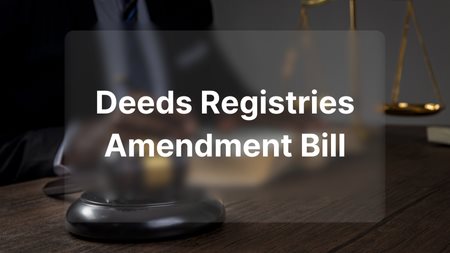Ownership of immovable property is not obtained on the signature of the offer to purchase document or even on payment of the purchase price. Ownership is only obtained on registration of the property, into the buyer's name, in the Deeds Registry Office.
Conveyancing is the legal process that takes place when lawful ownership is obtained of immovable property. Each time a property is sold; a new deed of transfer must be drawn up and registered. This is to ensure the security and certainty of an owner's title to his property.
The Three types of conveyancing attorneys involved in the property buying/selling process:
Transferring Attorneys
They transfer the property from the seller to the buyer.
They represent the seller and are appointed by the seller.
Registering (or Bond) Attorneys
They register the bond over the property in favour of the bank that is financing the purchase of the property.
They represent the buyer and the bank granting the buyer's home loan.
Appointed by the bank granting the buyer's home loan.
Cancellation Attorneys
They cancel the seller's existing home loan on the property.
They represent the bank cancelling the seller's home loan.
Appointed by the bank cancelling the seller's bond.
Conveyancing has become a very stressful profession, with conveyancers and their staff often under immense pressure to perform to clients' expectations.
Much of the process, which they have to coordinate, is actually out of their hands. They are heavily dependent on banks, city councils, revenue offices and other role players (including local deeds offices) to perform their duties by furnishing them with bond instructions, rates clearances and so on.
Conveyancers and their secretaries are delayed and compromised by buyers who fail to pay deposits or rentals on time, or by both buyers and/or sellers wanting to change agreements resulting in inevitable further delays. Often it is just one party that defaults, resulting in the other pressuring the conveyancer to remedy the situation, hassles with electrical certificates and latent defects pressurise conveyancers even further.
In a typical registration and transfer process the attorney is involved in more than 50 activities, involving up to 12 parties, before the transaction can be completed. In many towns the number of estate agents outnumber conveyancers by 25-1. Just consider that the conveyancer is probably the person who does the most for your property transaction. The conveyancer has to deal with all the parties involved and he assumes responsibility for the collection and payment of all amounts due.
As a Seller, what can you expect from your conveyancer?
The Conveyancer should:
Protect the interest of his client, the Seller, at all times and these interests should outweigh all other considerations except of course issues of legality;
Inform the seller of the conveyancing procedure and keep the seller informed of the progress of the transaction;
Advise the seller on the content of the Offer to Purchase, especially regarding suspensive conditions;
Advise the seller on the cancellation of his bond, any penalties, notice periods and other administrative charges which may affect the settlement figure;
Obtain the seller’s instruction before issuing any guarantees in respect of the transaction;
Do everything in their power to register the transaction on or as close as possible to the date agreed to in the offer to purchase;
Advise the seller on his obligations in terms of the offer to purchase, so as to ensure that the transfer is not delayed;
Meet with the seller to explain, as well as sign the necessary documentation in order to conclude the transaction;
Prepare the deeds for lodgement with care , so as to minimise the risk of rejection of the documentation by the Deeds Office;
Inform the seller of the transfer on the day of registration;
Account to the seller for finances relating to the transaction within two days after registration.
This article originally appeared in Property Power 11th Edition Magazine. To order your copy at the discounted price of R120, Click here




